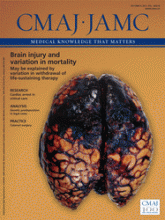The inclusion of dabigatran in the 2010 Canadian guidelines for stroke care,1 and more recently in the updated practice guidelines from the American College of Cardiology Foundation, American Heart Association and Heart Rhythm Association,2 is important because of the need for an alternative to warfarin for anticoagulation in patients with atrial afibrillation.
In his interesting commentary in CMAJ, Rudd emphasizes that dabigatran is recommended for patients meeting the inclusion criteria of the RE-LY (Randomized Evaluation of Long term anticoagulant therapY) trial.3 Rudd notices that this recommendation is made “despite a lack of data on the long-term safety and efficacy of this drug.” The guidelines appear to support the use of dabigatran as an alternative to warfarin without any restrictions. However, we expected a more critical update from the guideline developers on the RE-LY study that would have included some reservations about the use of this molecule.
First, Connolly and colleagues analyze their data under the intention-to-treat principle.4,5 In this specific case, because the analysis does not take into account the number of dropouts in the patient groups, it overestimates the effects of dabigatran by 4% to 11% for embolic or hemorrhagic cerebrovascular or transient ischemic attack. This observation is important given that dropout rates are higher in the groups receiving dabigatran (21%) than in those receiving warfarin (16%). On the contrary, analysis based on the number of patients who completed the study shows some modification of these results: the result for non-specific ischemia, dabigatran 150 mg v. warfarin, becomes nonsignificant (rate ratio [RR] 0.82, 95% confidence interval [CI] 0.64–1.05); the result for myocardial infarction becomes significant in favour of warfarin in comparisons of dabigatran 110 mg v. warfarin (RR 1.44, 95% CI 1.04–1.99) and dabigatran 150 mg v. warfarin (RR 1.49, 95% CI 1.07–2.49); and the result for hospital admissions becomes nonsignificant when comparing dabigatran 110 mg v. warfarin (RR 0.99, 95% CI 0.95–1.03).
Second, the RE-LY study shows that dabigatran requires an acid environment for absorption; hence, the addition of an acidifying agent is required to allow absorption, and this is what seems to cause dyspepsia and eventually hemorrhage with that molecule. Yet Connolly and colleagues present the results in patients with and without a proton pump inhibitor (PPI).5 Analysis of these results shows a marked reduction in the effectiveness of dabigatran 150 mg when taken with a PPI (RR 0.94, 95% CI 0.56–1.58). This is a predictable result, given the mechanism of action of PPIs. Thus, a warning should be issued about the use of dabigatran in patients taking a PPI until there are controlled studies that show its effectiveness under this condition. The use of PPIs and any antacids to prevent dyspepsia secondary to dabigatran should also be discouraged.
Out of concern for scientific rigour and to protect patients, we believe a warning about the use of dabigatran should be included in the recommendations to be issued in the Canadian practice guidelines on the possibility of substituting this new oral coagulant for warfarin.











